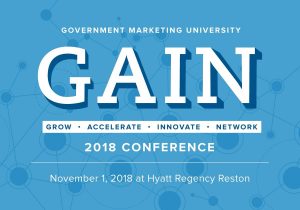
GAIN - which stands for Grow, Accelerate, Innovate, Network - has become the annual home for government marketers to come together and share challenges, tactics, and successes. This event, now in its third year, filled a void in the event landscape for government marketers.
Government marketing is a unique field given the strict guidelines that surround government purchasing. What works in the commercial market does not always translate to government. And speaking of translate, the government's acronym alphabet soup feels like a whole different language.
We spoke with Founder Lou Anne Brossman to find out what attendees should expect at this year's event.
What makes GAIN different from other federal events?
First, there's our focus on the marketers. When we started this event I had people come up to me and exclaim, "I've found my people!" Marketers are so busy and focused on their day to day that once they were able to take a step back and talk with peers they realized there was a huge value in the camaraderie of this field.
It's been exciting to watch people make connections. Our attendees started referring to themselves as GAINers both at the show and throughout the year. It's really been great to see this community form.
I think another unique aspect is this idea of community. GAIN was borne out of Government Marketing University (or GMarkU), a professional learning platform that takes a collaborative, community-based approach toward knowledge sharing and skill development in the field of public sector marketing.
We have over 60 gurus from all corners of the U.S. public sector marketplace -- marketers, thought leaders, government (current and former), media and sales leaders -- contributing their time and knowledge via classes and events. Sharing is not confined to one day - it continues year round with GMarkU.
Finally, I think a unique aspect of our event is the interplay between government executives and private sector marketers. We have ambassadors, many current and former government officials, that act as mentors to marketers, providing insight into what is happening on the government side. Continue reading




 When we
When we 

